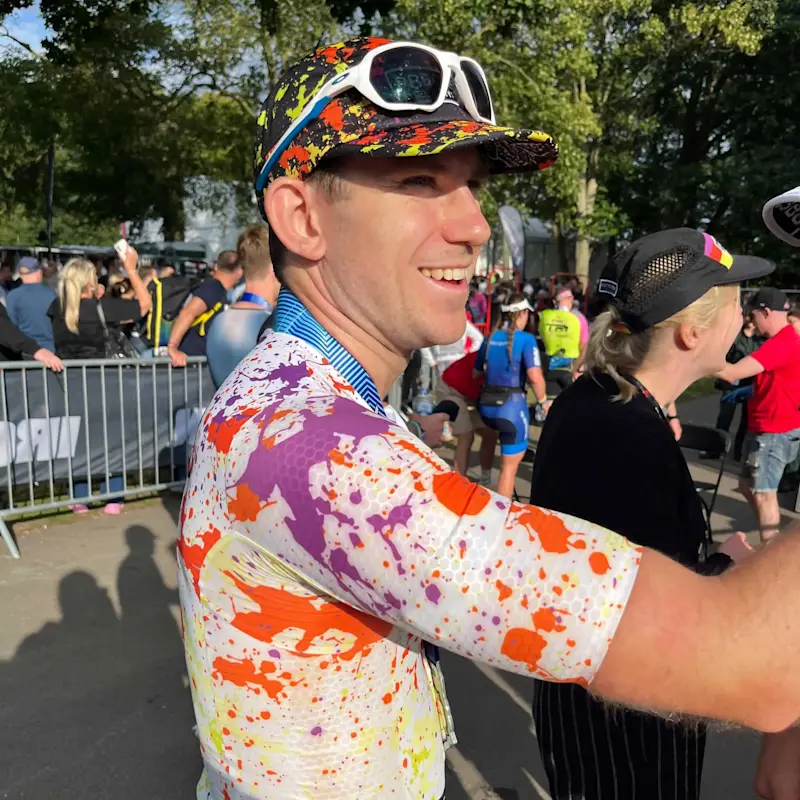
James Hatton
IRONMAN® Leeds
James' headline numbers
James' strategy
Fueling
Carbohydrate is the main fuel you burn when racing. Failing to fuel properly is a leading cause of underperformance in longer races.
Our Athlete Support Specialist, James ‘Ricky’ Hatton has a background in ultrarunning, but he decided to mix things up by tackling his first-ever triathlon, no less a full-distance one at IRONMAN® Leeds. True to our guidelines, Ricky had a carb-rich breakfast around 3 hours before the swim. He continued consuming carbs via an energy drink and some jelly babies, along with a PF 30 Chew in the final 30 minutes, all of which helped him start the race in a well-fed state and spare some of his stored glycogen. Knowing from experience that he struggles to consistently hit the high carb-per-hour targets that elite athletes often aim for, Ricky opted for a more conservative approach, targeting 75g/h. On the bike, he achieved his target (averaging ~74g/h), which set him up for a solid run even despite a snapped chain leading to a 39-minute mechanical stop. Ricky’s intake dropped to ~64g/h during the marathon, slightly less than his plan due to feeling bloated. Since this intake was almost his highest intake ever (second only to a ~4 hour running race at ~68g/h) he was likely close to his gut tolerance limit for how much carb he could comfortably consume over this duration. For future races of this length, Ricky could benefit from a more robust gut training program to improve his tolerance and reduce his symptoms of bloating. Overall, Ricky felt strong throughout the race and was able to finish the run well and with a smile on his face, a telling indicator of a successful fueling strategy.
Hydration
Taking on board an appropriate amount of fluid and sodium is essential to maintaining blood volume and supporting the cardiovascular effort needed to perform on race day.
Whilst the absolute amount of sodium and fluid consumed per hour is important, it’s critical to consider these in relation to each other. This is known as 'relative sodium concentration' and it’s expressed in milligrams per litre (mg/L). How much sodium you’re taking in per litre of fluid is more important than the absolute amount taken in per hour.
Sweat sodium concentration (mg/L) is largely genetically determined and remains relatively stable. Knowing how salty your sweat is enables you to replace a good proportion of your sweat losses, which can range from 200-2,000mg/L.
Whilst James’s losses are on the moderate side, getting his hydration strategy right is still crucial when it’s hot and/or humid as his higher sweat rate in these conditions can result in significant net losses over the duration of a race.
Learn moreWith a sweat sodium concentration of 1024mg/L, the on-course PH 1000 (Tablets) were the perfect match for Ricky and helped keep him from experiencing any dehydration symptoms such as cramping or dizziness. Ricky planned to consume 750ml/h on the bike, but dropping a couple of bottles early on meant he ended up consuming below his target (~521ml/h). The majority of his hydration came through the bottles of PH 1000 (Tablets he was able to pick up from aid stations, maintaining his electrolyte balance and setting him up nicely for the run, where he relied solely on cups of plain water and PH Electrolyte Capsules. This increased his relative sodium concentration dramatically during this section of the race. Ricky may benefit from increasing his fluid intake on the run to replace a higher percentage of his sweat losses and better match his sweat sodium concentration.
Caffeine
Beyond the Three Levers of Performance (carb, sodium and fluid), caffeine is one of only a few substances that is proven to improve performance for most endurance athletes as it can help stave off mental and physical fatigue.
Ricky’s caffeine intake was just below the recommended range of 3-6mg/kg, a level shown to deliver optimal performance benefits in endurance events. Since we know from his daily routine that he tolerates caffeine well (he rarely turns up to work without a caffeinated energy drink!), he could have pushed his intake up to within the guidelines to get an extra kick in the tougher moments of the race, such as by having another PF 30 Caffeine Gel.
How James hit his numbers
Here's everything that James ate and drank on the day...
James' weapons of choice
Final thoughts
James' full stats
Data Confidence?
There is an adequate level of accuracy in the data collected and the numbers reported. The athlete manages to recall what they ate and drank including most specifics (brands flavours quantities plausible estimations of volumes). However there are estimations made within the data which affect the overall confidence level in the data reported.